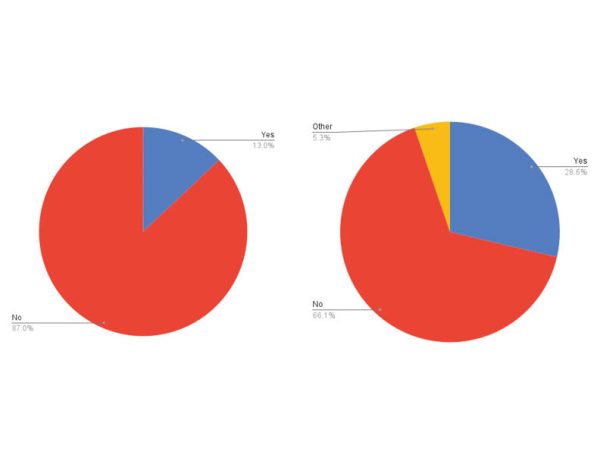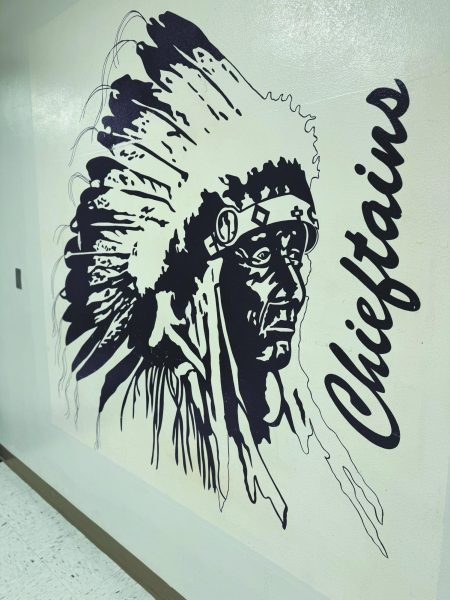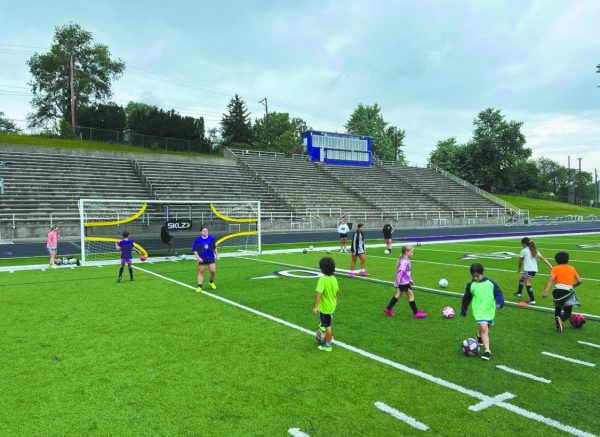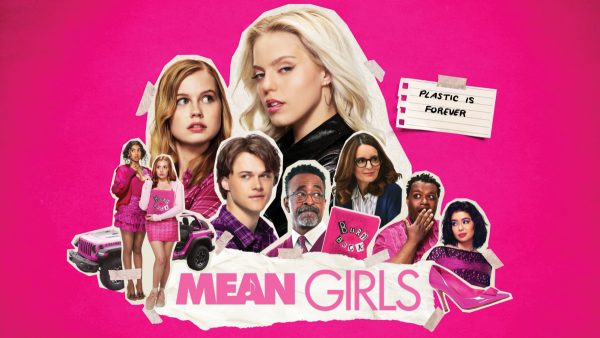

Starting off every school day with “Good morning, Chieftain Nation!” Loud warnings to not step on the Chieftain head. Hearing cheers of “Go Chieftains!”
Chieftain imagery is everywhere at Bellevue East, whether people recognize it or not. The Chieftain has been the mascot of Bellevue East High School since its founding. While the mascot’s intent is to honor native heritage, some students, staff, and community members have raised concerns about cultural appropriation and the negative impacts of the mascot.
“We’ve had a couple of speakers at our school board meetings that are really passionate either way about the mascot,” Bellevue Board of Education President Maureen McNamara said. “I don’t know that I would call it controversy; I just think there’s some different feelings or opinions out there.”
Bellevue East is not the only Bellevue school that has a Native mascot. Mission Middle School’s mascot is the “Braves,” likely meant to honor the bravery of Native Americans. Logan Fontenelle, named after the Omaha interpreter, has the “Warriors” as their mascot. Bellevue West’s mascot, the “Thunderbird,” is derived from the name of a powerful spirit that personified thunderstorms in Native American mythology.
“I like the Chieftain mascot… The term Chieftain means leader of the people, and so I think it’s a very honorable image,” community member John Carozza, whose three daughters attended Bellevue East, said. “There are some other Indian logos, like the Cleveland Indians used to use, that I can certainly see why folks thought those were offensive. But the Chieftain image is of a strong chief and of course the term Chieftain has a great history.”
Thirty-three percent of Bellevue East students say the mascot has encouraged them to learn about Native history, according to a student survey conducted by the Tom Tom. Carozza said the mascot is a way to remember local Native American history, including Omaha Chief Big Elk. According to the Sarpy County Museum, Chief Big Elk, also known as Ong-pa-ton-ga, was widely regarded as a strong leader and excellent speaker. He aligned with the United States in the War of 1812 and traveled to Washington D.C. to negotiate peace treaties.
“[The mascot] helps us to do some research and remember, you know, what was the origin of Bellevue,” Carozza said. “It was of course the Omaha Tribe and Chief Big Elk being a strong leader. I think it is a great example of how Bellevue Public Schools was trying to honor the local history with the image and the mascot’s name… So I’d be very disappointed if we changed it because I think we’d lose that element of honoring the history of the local area.”
While Native history in the United States is full of rich culture, it is also fraught with persecution and loss. According to PBS, exposure to diseases from European colonization killed up to 90% of indigenous people in the Americas. In the 19th century, Western expansion in the United States led to countless Native Americans being forced off their homelands. And between 1869 and the 1960s, the U.S. government sent hundreds of thousands of Native American children to boarding schools, which attempted to “civilize” them by forcing them to shed all aspects of their Native culture.
“There is no honor in Native American mascots as non-Natives do not honor the Native American truth—the true history that includes many acts of attempted genocide, betrayal, and broken treaties as well as the generational trauma and ongoing racism Native Americans experience to this day,” Edward T. Ventura, Jr., a member of the Prairie Band Potawatomi Nation, said.
Native American history – with both its beauty and its difficulties – is complex and ongoing. Many Native youth face struggles to this day, including poverty and mental health issues. According to the Centers for Disease Control, Native youth are 2.5 times more likely than the rest of the population to die by suicide.
“I think that just because we have such a small population of Native American students– I can count on my hand how many Native American students we have in the school– so [the mascot] doesn’t affect them on a personal level,” senior Gabriella Bullie, a member of the Omaha Tribe, said. “Because it is a very underrepresented community that is being caricaturized, I don’t think that it gets a lot of attention.”
Opponents of Native mascots argue that they enforce stereotypes of Native Americans being “savage” or “uncivilized.” While Native mascots typically do not intend to stereotype or negatively portray Native Americans, research shows that they may influence subconscious biases. A 2010 study by Chu Kim-Pietro et al. found that non-Native college students were more likely to stereotype racial minority groups after being exposed to a Native American mascot.
“The Native American mascots supported by the Bellevue Public Schools perpetuate negative stereotypes in the community psyche, enabling discrimination, inequity, and continued injustices towards Native Americans,” Ventura said. “These mascots have no place in the 21st century.”
Because many school mascots are animals, presenting a Native American as a mascot may be seen as dehumanizing. In a 2011 study by A.R. LaRocque et al., Native students experienced symptoms of distress and dysphoria after viewing a Native masco t– even Native mascot imagery that was not considered controversial. In fact, 23.8% of East students stated that the Chieftain mascot made them feel distressed, sad, or angry.
“As a Native American myself, it’s very degrading. It’s very upsetting to see it every day when it’s such a grotesque image,” Bullie said. “I think that they should listen to actual Native Americans, who have repeatedly and vocally stated that this [Native mascot] is not honoring us.”
Many community members believe that Bellevue East has permission from the Omaha Tribe – also known as Umoⁿhoⁿ – to use the Chieftain as a mascot. Superintendent Dr. Jeff Rippe stated that the Omaha Tribe has not given Bellevue East permission to use the Chieftain mascot because the tribe does not own the rights to Chieftain imagery. The Omaha Tribe did not respond to Tom Tom requests for comment.
“Around 15 years ago… students, staff members, and tribal members visited Bellevue for a full day to talk about why Bellevue has several Native American mascots as a part of our school district,” Rippe said. “After that visit, the Omaha Nation Tribe shared their appreciation on… our use of the mascots and how our students honored Native Americans.”
In 2006, the Nebraska Department of Education encouraged schools to reconsider the use of Native American mascots. Several local schools have moved away from Native mascots– for example, the University of Nebraska Omaha retired its Native mascot in 1971, and Millard South moved from the Indians to the Patriots in 2000. However, according to the Nebraska School Activities Association, 22 schools across Nebraska still use Native mascots.
“Our school board has discussed [the mascot]. And I think we’ve had that discussion in light of people who have expressed their feelings or opinions either way,” McNamara said. “I know that some of our staff have visited with various individuals of different tribes in the area, and I think that… if we had an overwhelming, a resounding feeling, we would obviously do some more research.”
Cost is a factor that many point to when considering changing mascot imagery. The Denver Post reported that one high school in Colorado spent around $350,000 on rebranding their mascot. A bill introduced to the Nebraska state legislature in 2022 would have provided schools with up to $200,000 to change Native mascots. While the bill never passed, there are other efforts to help with the cost of mascot changes. For example, in 2015, the athletic apparel company Adidas announced that it would offer high schools free design resources to change their Native mascots.
“I don’t see it [the Chieftain mascot] staying forever because… they’re getting more and more pressure to change the mascots just because people are becoming more aware of the negative effects it has,” Bullie said.
Conversations about the Chieftain mascot will likely continue to evolve. Whether one finds the Chieftain mascot problematic or honorable, Carozza said it is important to appreciate other perspectives.
“I think it’s important that we respect everyone’s opinions, and that we do treat each other with honor, with dignity and respect,” Carozza said.
![Ensuring safety. If given a reason, the school resource officer reserves the right to search a student’s belongings. As a safety precaution, SROs wear gloves when searching a student’s backpack. “So [for a] backpack search, if we have to do a backpack search, we have to have a few things. We have to have existent circumstances, probable cause, or we have to have reasonable articulable suspicion which we would request from the school administrator or teacher to search a backpack,” School Resource Officer Jonathan Hobbs said.](https://thechieftainspear.org/wp-content/uploads/2024/05/hobbs-photo-Medium-450x600.jpeg)









